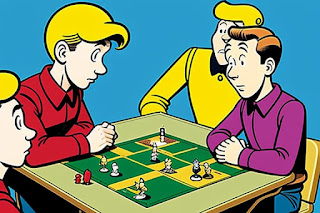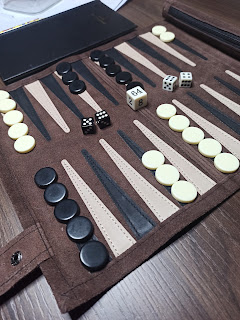The landscape of board games has undergone significant transformation since the 1990s. Gone are the days of simple roll-and-move mechanics (think Monopoly or Ludo) and passive player experiences. Today, modern board games offer rich strategic depth, elaborate themes, and a focus on player interaction, fuelling a global resurgence in the hobby. This blog aims to explore the key innovations in game mechanisms and player preferences that have driven this evolution, analysing their influence on published games and the European market's unique contribution to the phenomenon. Additionally, a glimpse into the resurgent popularity of Dungeons & Dragons (D&D) will provide a broader perspective on the current state of the tabletop gaming sector.
The Rise of the Eurogame and Strategic Depth
The 1990s witnessed the rise of the
"Eurogame”, a term initially used to distinguish European-designed games
from their American counterparts. Eurogames
typically emphasise strategic decision-making, resource management, and
indirect player interaction through shared goals or economic competition.
Pioneering titles like "The Settlers of Catan" (1995) introduced
innovative mechanics like dice-rolling for resource acquisition and trading
with neighbouring players. This sparked a wave of innovative games like "Carcassonne"
(2000), introducing tile-laying mechanics, and "Puerto Rico" (2002),
which introduced role-selection mechanisms that offered players unique
abilities each round. These games offered a refreshing alternative to
traditional luck-based games, attracting a new generation of players seeking
intellectual challenges and strategic depth.
Player Interaction: From Competition to
Collaboration
While the introduction of strategic depth in board games was a major innovation, player interaction also evolved significantly. Early games often focused on direct competition, with players vying for resources or victory points. However, modern board games explore a wider range of interaction models. Cooperative games, where players
work together against a common enemy or objective, rose in popularity. Titles like "Pandemic" (2008) require players to collaborate to manage disease outbreaks, while "Hanabi" (2010) presents a unique cooperative experience where players cannot see their own cards, relying instead on communication and deduction to win. Additionally, social deduction games like "The Resistance" (2008) introduced hidden roles and bluffing mechanics, creating an interesting experience which combines social manipulation with hidden agendas. These diverse forms of interaction cater to a wider range of player preferences, fostering a stronger sense of a shared experience and greater engagement with the game being played.
Thematic Immersion and Storytelling
Modern board games go beyond mechanics, offering
rich thematic experiences. Most of the more popular modern titles are
meticulously crafted around specific themes, from historical periods
("Twilight Struggle," 2005) to fantastical worlds ("Gloomhaven,"
2017). Excellent artwork, well-thought-out components, and captivating narratives
contribute to the overall experience, drawing players into the game's world.
This focus on theme goes beyond mere looks; it can enhance gameplay by providing
a logical framework for mechanics and player actions. Essentially, the theme
justifies the actions taken within the context of the game itself. For
instance, the worker placement mechanic in "Agricola" (2007)
thematically represents managing a farm, while the card drafting mechanic in
"7 Wonders Duel" (2015) simulates drafting historical advancements
for your civilisation through a logical sequential path, starting from the most
primitive human discoveries to the more complex cultural and societal achievements.
This thematic integration creates a more engaging and memorable experience for
players.
The Powerhouses of Publishing: Ravensburger,
Fantasy Flight Games, and Asmodee
The "German Model" of board game
design, characterised by high-quality components, innovative mechanics, and a
focus on strategy, has significantly shaped the modern board game landscape.
Linked to this increase in popularity of the German model, several companies
came to the fore addressing the lacuna in distribution and availability of
specific board game titles beyond their country of origin. By making it easier
to translate published games and catering for a wider, more globalised market, these
companies have extended the reach of this model to a new and growing audience
of hobbyists the world over.
Founded in 1883, Ravensburger is a German giant with a long history of producing high-quality family games. While not solely focused on complex strategy games, Ravensburger titles often introduce innovative mechanics and beautiful artwork, making them accessible gateways into the world of modern board games. Puerto Rico (2002) is one such title. This classic tile-laying and resource management game puts players in the shoes of colonial governors vying for dominance on the island of Puerto Rico. Players collect resources, build structures, and ship goods back to Europe for points. The Castles of Burgundy (2011) is a strategic dice-placement game where players vying for control of various regions in Burgundy. Players collect resources, construct buildings, and develop their holdings to score the most points. Core elements introduced in both these games can be found in many modern Eurogames.
Established in 1995 in Minnesota, USA, Fantasy
Flight Games (FFG) initially focused on translating and publishing European
games for the North American market. They quickly rose to prominence, acquiring
licenses for popular Eurogames like "Ticket to Ride" (2004) and
"Power Grid" (2004), introducing them to a wider audience. FFG also
ventured into their own game design, creating thematic and strategically rich
titles like "Twilight Struggle" (2005) and the epic campaign game
"Descent: Journeys in the Dark" (2012), further solidifying their
reputation for high production value and strategic depth.
Asmodee is a French
publisher of board games, card games and role-playing games (RPGs). Founded in
1995 to develop their own games and to publish and distribute for other smaller
game developers, they have since acquired numerous other board game publishers.
They acquired major European publishers like Days of Wonder ("Ticket to
Ride") and Fantasy Flight Games, creating a vast portfolio of Eurogames, thematic
strategy titles, and licensed properties like "Star Wars" and
"Arkham Horror." Asmodee's influence extends beyond publishing, with
their distribution network ensuring wider availability of games across the
globe.
Essen Spiel: A Mecca for Gamers and Industry
Powerhouse
International game fairs play a crucial role in
promoting the "German Model" and the broader board game industry.
Essen Spiel, held annually in Essen, Germany, is the largest and most
influential fair in the world. Thousands of publishers, designers, and gamers
gather to showcase new releases, network, and participate in tournaments. This
event serves as a crucial launchpad for new games, generating global attention
and driving sales. Additionally, Essen Spiel provides a platform for smaller European
publishers to reach a wider audience, fostering diversity within the industry.
The Impact on the Market
The influence of the "German Model" and Essen Spiel extends beyond Europe. The success of Eurogames and
the efficient distribution networks of major publishers have led to a wider availability of board games worldwide. Titles originally published in Germany are now readily available in countries across Asia, North America, and South America.
The popularity of Eurogames has fuelled the
growth of board game cafes, offering a welcoming space for players to explore
new titles and enjoy the social aspects of the hobby. This trend further
exposes players to the "German Model" and other modern game design
philosophies.
Platforms like Board Game Geek (BGG) provide a
forum for players to discuss games, share reviews, and connect with others who
share their passion. This online community promotes awareness of Eurogames and
other modern titles, creating a global network of enthusiastic players.
Beyond Essen Spiel: The Rise of Regional Powerhouses
Europe boasts several
prominent conventions beyond Essen Spiel, each catering to specific tastes and
interests. The UK Games Expo (UKGE), held annually in Birmingham, England, has
grown significantly in recent years. Attendance figures jumped from 5,805 in
2013 to over 52,000 in 2023, solidifying its position as the largest dedicated
board game convention in the UK. UKGE offers a comprehensive experience,
showcasing new releases, hosting tournaments for popular games, and providing a
platform for smaller publishers and designers.
Similarly, Airecon, held in
Harrogate, England, has emerged as a popular convention focused on strategy
board games. With an emphasis on Eurogames and a strong focus on competitive
play, Airecon attracts a dedicated crowd of
passionate gamers. While significantly smaller in scale than UKGE, Airecon
fosters a tight-knit community atmosphere and provides a space for players to
delve into the complexities of strategic board games.
North America is home to a
vibrant network of conventions catering to a diverse range of board game
enthusiasts. Gen Con, held annually in Indianapolis, Indiana, is a titan of the
industry. While encompassing a broader gaming spectrum including video games
and tabletop RPGs, Gen Con boasts a sizable board game presence. Attendance
figures regularly exceed 60,000, making it one of the largest gatherings of
board game players in the world. Gen Con features a massive expo hall with
publisher booths, demo areas, and opportunities to meet designers and playtest
unreleased titles. Additionally, it hosts tournaments for various games,
attracting competitive players from across the globe.
The United States also boasts
regional conventions like PAX Unplugged, held in Philadelphia, Pennsylvania.
PAX Unplugged focuses primarily on tabletop gaming, offering a curated
selection of board games, role-playing games, and card games. With a strong emphasis
on indie publishers and innovative game design, PAX Unplugged caters to a
specific audience seeking unique experiences. Additionally, events like Dice
Tower Con in Orlando, Florida, and BGG.CON in Dallas, Texas, cater to specific
gaming preferences and local communities, contributing to the overall health
and diversity of the convention scene.
The
Impact on the Gaming Market
These regional conventions
play a crucial role in supporting and promoting the board game industry. Conventions
provide a critical platform for publishers, both established and fledgling, to
showcase their games to a large and enthusiastic audience. This exposure can
lead to increased sales, distribution deals, and brand recognition.
Additionally, conventions offer a valuable opportunity for publishers to gather
direct feedback from players, informing future game design and development.
Conventions engender a sense
of community as well as a shared passion for board games. Players can connect
with others who share their interests, participate in tournaments, and learn
about new games. This sense of community encourages continued engagement with
the hobby and drives sales within the local market.
Conventions create a buzz
surrounding upcoming releases. Players get a chance to playtest unreleased
games, generate word-of-mouth excitement, and pre-order upcoming titles. This
hype generation can translate into strong initial sales figures for publishers
and generate excitement within the broader gaming community.
Growth
Drivers and Future Trends
The continued growth of
regional conventions hinges on several factors.
They provide a more accessible option for players who may not
have the resources to travel to large international events like Essen Spiel.
This allows for a wider range of players to participate and engage with the
broader gaming community.
Some conventions focus on specific genres or player preferences,
catering to a dedicated audience. This caters to the diverse tastes of modern
board game enthusiasts and attracts players seeking a tailored experience. Furthermore, they
are increasingly leveraging online platforms to enhance the experience.
Features like pre-registration, virtual demos, and live streaming events can
further expand reach and connect with players who cannot attend physically.
Catering to a Diverse Audience: A Boon for Choice
The rise of niche markets and diverse player
preferences has undoubtedly expanded the selection of available games.
Platforms like Kickstarter allow designers to directly gauge interest in
specific mechanics or themes, leading to a wider variety of games catering to
specific player desires. This empowers players with greater choice and allows
designers to explore unique concepts that might not have found a publisher
traditionally. For instance, the popularity of solo-play games has seen a surge
in titles designed specifically for one player, offering a fulfilling
experience without requiring a group.
The Pressure of Production Value: A Rising Cost
However, the demand for high-quality components
and thematic immersion can inflate production costs. Players today expect
visually appealing artwork, premium game pieces, and durable components, all
contributing to the overall experience. While Kickstarter funding can help
mitigate these costs, it also creates a pressure for publishers to deliver on
increasingly lavish production values to stand out from a crowded market. This
can lead to higher retail prices for consumers, potentially creating a barrier
to entry for new players or those on a budget.
Complexity Creep: Balancing Depth with
Accessibility
The focus on strategic depth can sometimes lead
to "complexity creep," where games become increasingly intricate and
difficult to learn. While some players relish the challenge, complex rulebooks
and lengthy playtime can alienate casual players. Striking a balance between
strategic depth and accessibility is crucial. This might involve streamlined
rules, modular components that allow for variable difficulty levels, or
well-designed tutorials to ease players into the gameplay.
The Future: Finding the Sweet Spot
Navigating the influence of player preferences
requires a delicate touch from publishers and designers. Understanding your
target audience is essential. Kickstarter data, online forums, and playtesting
sessions can provide valuable insights into player desires. Additionally,
publishers can explore ways to offer a range of titles that cater to different
levels of complexity and budgets.
One approach is the "core game" model,
where a base game offers a streamlined experience with the potential for
expansion modules that add complexity and depth for experienced players. This allows for a broader appeal, attracting
new players with the base game while offering additional content for those
seeking a more challenging experience.
Dungeons & Dragons: A Gateway to Tabletop
Adventures
Dungeons & Dragons (D&D) has
seen a surge in popularity in recent years, but its roots go deep. Created in
the mid-1970s, D&D took inspiration from wargames and fantasy literature to
establish a new genre: the tabletop role-playing game (RPG). Players create
characters and embark on adventures within a world crafted by a Dungeon Master
(DM). The core mechanic relies on rolling polyhedral dice (like the 20-sided
die) to determine success or failure, adding an exciting layer of chance to the
storytelling.
Several factors have fueled D&D's recent resurgence. The
release of the streamlined 5th edition in 2014 made the game more accessible to
new players. Pop culture references, like the portrayal of a D&D club in
the Netflix series "Stranger Things," brought the game to a wider
audience. The rise of online platforms like Roll20 further expanded D&D's
reach, allowing geographically distant friends to connect for virtual sessions.
D&D's longevity can be attributed to its inherent flexibility. The core rules provide a framework, but DMs can create custom campaigns tailored to their players' interests. This fosters a sense of community and shared storytelling that transcends the game itself.
The impact of D&D's resurgence extends beyond the game
itself. The influx of new players has fueled interest in the broader tabletop
RPG market. Publishers are releasing new and innovative games, catering to
diverse tastes and interests. Local game stores are seeing a rise in tabletop
RPG nights, creating vibrant social spaces for hobbyists.
D&D's resurgence highlights the enduring appeal of
tabletop gaming. In an increasingly digital world, these games offer a unique
opportunity for face-to-face interaction, collaborative storytelling, and
creative expression. While D&D may be the current star, its success paves
the way for a brighter future for tabletop gaming as a whole.
The Future of Modern Board Games: A Look Ahead
The future of modern board games appears bright. Technological advancements are creating new possibilities for integrating digital elements into the tabletop experience. Apps can streamline gameplay setup, track resources,
and even introduce AI-controlled opponents, expanding the accessibility and potential complexity of games. Additionally, the global market for board games continues to grow, with emerging markets in Asia offering exciting opportunities for publishers and designers.
However, some challenges remain. The sheer volume of new releases can be overwhelming for players, and ensuring high-quality components can be a balancing act for publishers. Additionally, the rise of digital alternatives like video games presents competition for players' time and attention.
Despite the challenges, the modern board game industry is thriving. A passionate community of players and designers continues to push boundaries, experiment with new mechanics, and explore diverse themes. The focus on strategic depth, thematic immersion, and a variety of player interactions has created a vibrant and engaging hobby that caters to a wide range of interests. Whether it's the strategic battles of a Eurogame, the collaborative challenges of a cooperative title, or the narrative adventures of D&D, the modern tabletop gaming scene offers a rich and rewarding experience for players of all ages and backgrounds.
.jpeg)
.jpeg)
.jpeg)
.webp)
.jpeg)














.jpeg)
.jpeg)


